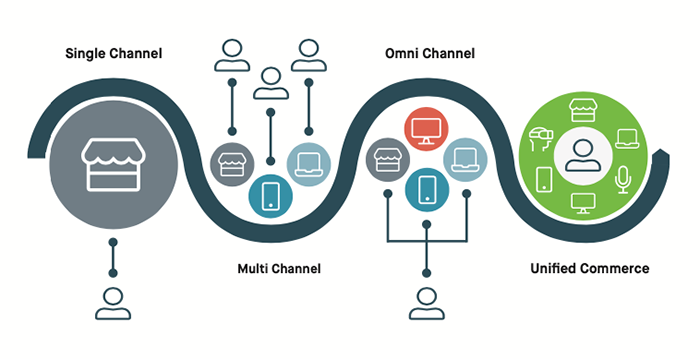To understand Unified Commerce, it would be helpful to be aware of the journey that commerce has undergone, in recent years. From single channel, where only one sales channel is offered; to multi-channel, where different physical and digital channels exist, side-by-side; to omnichannel and Unified Commerce, where the different channels collaborate with each other, in order to offer a cohesive customer experience, in all channels.

But what exactly is the difference between Omnichannel and Unified Commerce? Simply put, omnichannel primarily concerns the transactional part of sales; while Unified Commerce is more focused on the shopping experience, itself.
Unified Commerce puts the customer at the center; in order to create a personalized customer experience, in real time. Instead of seeing different channels as their own silos, that interact with each other; you see all channels, as part of one and the same whole. There is a clear focus on creating a unified experience, for the customer; regardless of channel. The customer must be able to move entirely frictionlessly between different channels, during their purchase journey. It must be possible to start a purchase in any channel, and end it in any channel. For this to work in practice, it requires that the sales channels are always synchronized.
With omnichannel, there is a risk that the customer experiences several different realities, as data and functionality are often handled in different systems; which are not always in sync. To really succeed, the merchant must have all the pertinent information, regarding the customer; and all data should, preferably, be integrated in one and the same system. If there are several systems; these need to “talk to” each other, in real time. The goal is to create a frictionless world, where only “one truth” exists.
With Unified Commerce, there is no discrepancy in data between different channels. It provides the conditions to communicate and interact with the customer, throughout the customer journey; regardless of what each individual customer journey looks like, or what touchpoints that journey includes. By connecting the customer all the way to the purchase, the probability increases that the transaction actually takes place in one of the channels that you offer, yourself; instead of with a competitor.
Feel free to read about our adapter with the cash register system Sitoo, which makes it possible to create modern Unified Commerce solutions, in an efficient way!



